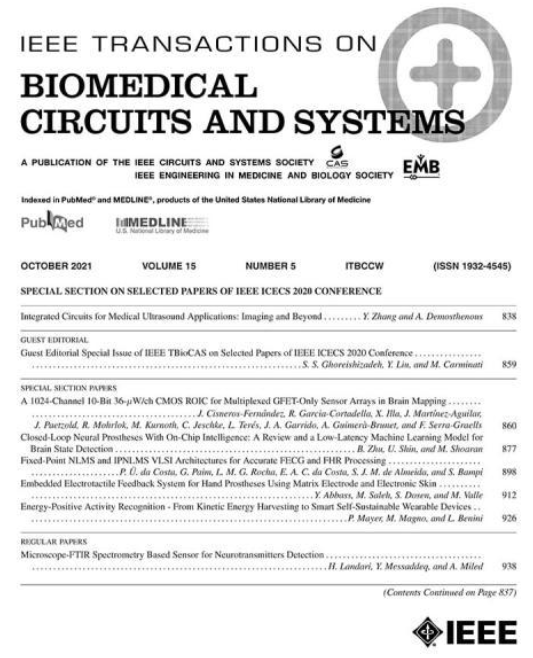用于生物医学植入物的0.04 mm$^2$ Buck-Boost DC-DC转换器,采用自适应增益和离散频率缩放控制
IF 4.9
2区 医学
Q2 ENGINEERING, BIOMEDICAL
IEEE Transactions on Biomedical Circuits and Systems
Pub Date : 2016-06-01
DOI:10.1109/TBCAS.2015.2480035
引用次数: 15
摘要
本文介绍了一种可重构的buck-boost开关电容DC-DC变换器的设计,适用于广泛的生物医学植入物。所提出的变换器具有极小的占地面积,并使用一种新颖的控制方法,允许粗和细控制输出电压。该转换器采用自适应增益控制、离散频率缩放和脉冲跳变方案来调节输出电压和负载范围内的功率。自适应增益控制用于从可重构功率级实现可变开关增益比,从而在输出电压中进行粗阶跃。当输出电压在目标输出电压的10%以内时,通过开关频率的离散变化来改变输出给负载的功率,并进行微调。控制体系结构主要是数字的,它已经作为一个完全集成的开关电容器转换器设计的一部分实现,使用标准的大块CMOS 0.18 μm工艺。测量结果表明,该变换器的输出电压范围为1.0 ~ 2.2 V,可提供高达7.5 mW的负载功率,效率高达75%,有效面积仅为0.04 mm2,明显小于其他设计。这种低面积、低复杂度、可重构的功率转换器可支持生物医学植入应用中的低功耗电路。本文章由计算机程序翻译,如有差异,请以英文原文为准。
A 0.04 mm$^2$ Buck-Boost DC-DC Converter for Biomedical Implants Using Adaptive Gain and Discrete Frequency Scaling Control
This paper presents the design of a reconfigurable buck-boost switched-capacitor DC-DC converter suitable for use in a wide range of biomedical implants. The proposed converter has an extremely small footprint and uses a novel control method that allows coarse and fine control of the output voltage. The converter uses adaptive gain control, discrete frequency scaling and pulse-skipping schemes to regulate the power delivered to a range of output voltages and loads. Adaptive gain control is used to implement variable switching gain ratios from a reconfigurable power stage and thereby make coarse steps in output voltage. A discrete frequency scaling controller makes discrete changes in switching frequency to vary the power delivered to the load and perform fine tuning when the output voltage is within 10% of the target output voltage. The control architecture is predominately digital and it has been implemented as part of a fully-integrated switched-capacitor converter design using a standard bulk CMOS 0.18 μm process. Measured results show that the converter has an output voltage range of 1.0 to 2.2 V, can deliver up to 7.5 mW of load power and efficiency up to 75% using an active area of only 0.04 mm2, which is significantly smaller than that of other designs. This low-area, low-complexity reconfigurable power converter can support low-power circuits in biomedical implant applications.
求助全文
通过发布文献求助,成功后即可免费获取论文全文。
去求助
来源期刊

IEEE Transactions on Biomedical Circuits and Systems
工程技术-工程:电子与电气
CiteScore
10.00
自引率
13.70%
发文量
174
审稿时长
3 months
期刊介绍:
The IEEE Transactions on Biomedical Circuits and Systems addresses areas at the crossroads of Circuits and Systems and Life Sciences. The main emphasis is on microelectronic issues in a wide range of applications found in life sciences, physical sciences and engineering. The primary goal of the journal is to bridge the unique scientific and technical activities of the Circuits and Systems Society to a wide variety of related areas such as: • Bioelectronics • Implantable and wearable electronics like cochlear and retinal prosthesis, motor control, etc. • Biotechnology sensor circuits, integrated systems, and networks • Micropower imaging technology • BioMEMS • Lab-on-chip Bio-nanotechnology • Organic Semiconductors • Biomedical Engineering • Genomics and Proteomics • Neuromorphic Engineering • Smart sensors • Low power micro- and nanoelectronics • Mixed-mode system-on-chip • Wireless technology • Gene circuits and molecular circuits • System biology • Brain science and engineering: such as neuro-informatics, neural prosthesis, cognitive engineering, brain computer interface • Healthcare: information technology for biomedical, epidemiology, and other related life science applications. General, theoretical, and application-oriented papers in the abovementioned technical areas with a Circuits and Systems perspective are encouraged to publish in TBioCAS. Of special interest are biomedical-oriented papers with a Circuits and Systems angle.
 求助内容:
求助内容: 应助结果提醒方式:
应助结果提醒方式:


